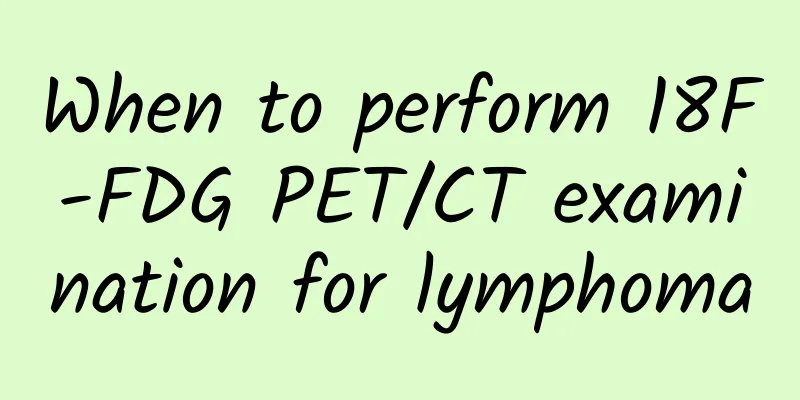When to perform 18F-FDG PET/CT examination for lymphoma

|
Lymphoma, also known as malignant lymphoma, is a general term for a group of malignant tumors originating from the lymphatic hematopoietic system. It is one of the tumors with the fastest increasing incidence in China, and its mortality rate ranks among the top 10 among all types of malignant tumors. In recent years, with the continuous deepening of human understanding of the nature of lymphoma, many new research results have emerged in the diagnosis and treatment of lymphoma. 18F-FDG PET/CT imaging technology has been widely used in the initial staging, restaging, early treatment response and efficacy evaluation, prognosis prediction and follow-up of lymphoma patients, which has improved the survival of patients. 1. Diagnosis and initial staging of lymphoma The initial treatment plan for lymphoma patients is determined based on the histological subtype of lymphoma, the presence of risk factors before treatment, and accurate disease staging. 18F-FDG PET/CT imaging shows high diagnostic sensitivity and specificity in the initial staging of lymphoma, which is higher than CT scan and enhanced CT scan, especially for the detection of lymphoma involvement with no or slight anatomical abnormalities on CT (such as normal-sized lymph nodes, bone marrow, spleen and gastrointestinal tract involvement, etc.). 18F-FDG PET/CT has obvious advantages. Currently, 18F-FDG PET/CT imaging is part of the pre-treatment evaluation of Hodgkin lymphoma (HL) and most aggressive non-Hodgkin lymphomas (NHL), especially for HL and diffuse large B-cell lymphoma (DLBCL), and is also helpful for the diagnosis and treatment of some patients with other histological types. 18F-FDG PET/CT imaging before treatment can detect some lesions that are not shown on CT scans, change the clinical stage of 15% to 20% of patients, and change the treatment plan of 8% of patients. 18F-FDG PET/CT imaging can replace bone marrow biopsy for HL and some DLBCL. When positive sites are found outside the identified lesions, or when the sites of 18F-FDG PET/CT positive lesions are inconsistent with the common clinical manifestations of lymphoma, additional clinical or pathological evaluation is recommended. 2. Interim restaging of lymphoma and evaluation of treatment response 18F-FDG PET/CT imaging has shown high diagnostic sensitivity and specificity in restaging of lymphoma and is increasingly used in evaluating treatment response. However, when choosing 18F-FDG PET/CT imaging for reexamination, it should be considered only for patients with positive baseline imaging results. It is generally not recommended when the baseline imaging results are negative. The NCCN Guidelines (2020, 2nd Edition) point out that 18F-FDG PET/CT has better restaging and prediction value for progression-free survival (PFS) and overall survival (OS) than other examinations after 2 cycles of HL chemotherapy. It is recommended to score the interim 18F-FDG PET/CT imaging results according to the Deauville criteria, and different clinical treatment plans are recommended for patients with different Deauville scores. For DLBCL and peripheral T-cell lymphoma, interim 18F-FDG PET/CT examinations are recommended, but the timing of use has not yet been fully clarified. If the imaging results are used directly to guide changes in the treatment plan, it is recommended to re-biopsy the residual lesions to confirm the positive results; for patients who have developed a complete treatment course, even if the interim examination shows metabolic remission, the entire planned course of treatment should be completed. The 18F-FDG PET/CT efficacy evaluation criteria for NHL are the Lugano efficacy evaluation criteria based on the Deauville 5-point method. 3. Evaluation of efficacy at the end of lymphoma treatment It is generally recommended for patients with the following conditions: positive results of 18F-FDG PET/CT imaging before and during treatment, changes in tumor FDG uptake during interim restaging, or large residual lesions even though FDG activity has returned to normal. Since 18F-FDG PET/CT has been included in the efficacy evaluation criteria, baseline examinations are required to achieve the best interpretation of post-treatment monitoring. 18F-FDG PET/CT imaging is an important tool for evaluating the efficacy of HL and DLBCL patients after treatment, especially for distinguishing whether the residual mass is fibrosis or whether there is still viable tumor tissue. Clinical studies have shown that 18F-FDG PET/CT imaging is also of great value in the evaluation of other FDG-sensitive lymphomas, including peripheral T-cell lymphoma, follicular lymphoma, BL and mantle cell lymphoma, and the evaluation of efficacy response after treatment is correlated with prognosis. In order to minimize treatment-related inflammatory reactions, it is usually recommended to perform 18F-FDG PET/CT examinations 6 to 8 weeks after chemotherapy and 8 to 12 weeks after radiotherapy. 4. Guiding radiotherapy strategies Accurate staging helps to select curable patients for radiotherapy. For example, PET can more accurately determine According to the FL staging, the 5-year PFS of FL patients with 18F-FDG PET/CT staging of stage I to II after radiotherapy is nearly 70%. For patients with stage I to II HL, even if the 18F-FDG PET/CT efficacy evaluation is complete remission (CR) after 2 cycles of chemotherapy, it is not recommended to omit radiotherapy. Comprehensive treatment is recommended. The disease control rate of chemotherapy alone is significantly lower than that of comprehensive treatment. The Deauville 5-point scale score can be used to guide the formulation of radiotherapy plans; only when the radiation dose to the heart, lungs and breast is high, the long-term potential toxicity of treatment can be fully discussed with the patient, and radiotherapy can be considered. For patients with stage III to VI HL, after enhanced chemotherapy, 18F-FDG PET/CT is performed to evaluate residual lesions with a diameter greater than 2.5 cm, and radiotherapy is recommended for positive lesions. For patients with DLBCL who are evaluated as CR by 18F-FDG PET/CT during or after chemotherapy, those with stage I to II without adverse prognostic factors have a better effect by completing chemotherapy alone without adjuvant radiotherapy. Those with positive PET can choose radiotherapy. For patients who are evaluated as CR after chemotherapy but have large masses before treatment and extranodal lesions, radiotherapy is recommended. 5. Monitoring for recurrence of lymphoma Studies have found that 18F-FDG PET/CT can help detect recurrent lesions, but there is currently insufficient evidence to show that PET can be used as a routine imaging for post-relapse monitoring, and CT examinations are generally used as routine imaging. 18F-FDG PET/CT imaging is recommended when patients with a history of HL, invasive or intermediate subtype NHL are found to have clear or suspected recurrence through physical examination, laboratory tests or conventional imaging methods. When patients who have remission after treatment are suspected of recurrence, 18F-FDG PET/CT imaging can be used for evaluation. Lesions that persist on certain CT images can also be imaged using 18F-FDG PET/CT to determine whether there are lymphoma lesions. 6.18F-FDG PET/CT for the detection of aggressive lymphoma transformation and guidance of biopsy During the development of indolent B-cell lymphoma (such as CLL/SLL, FL and marginal zone lymphoma), some patients may transform into aggressive lymphoma (such as DLBCL). 18F-FDG PET/CT is helpful in detecting this transformation. When 18F-FDG PET/CT imaging finds an increase in lesions and/or a significant increase in the maximum standard uptake value (SUVmax) compared with the previous one, it indicates that transformation has occurred. Under the guidance of 18F-FDG PET/CT, biopsy and histological confirmation should be performed on lesions with significantly increased metabolism to further clarify whether transformation has occurred. 7. Prognostic evaluation of lymphoma Tumor burden before treatment is the most important predictor of treatment efficacy and recurrence. For patients with HL, DLBCL, peripheral T-cell lymphoma, etc., the tumor metabolic volume (MTV) and total lesion glycolysis (TLG) measured by baseline 18F-FDG PET/CT before treatment are powerful predictors that can predict patient survival. Mid-treatment 18F-FDG PET/CT imaging has a prognostic role in patients with DLBCL, peripheral T-cell lymphoma, and NK/T-cell lymphoma in HL and NHL. Many studies have shown that PET results are associated with PFS and OS outcomes. PET-negative patients have significantly longer PFS and OS than PET-positive patients, and have a better prognosis. For HL, most studies have shown that after 2 courses of chemotherapy, 18F-FDG PET/CT imaging has a high predictive value and can accurately determine the prognosis. For DLBCL, most literature has affirmed the value of mid-treatment 18F-FDG PET/CT imaging in predicting prognosis, and the evaluation criteria generally use the Deauville 5-point method. 8. Evaluation before lymphoma stem cell transplantation Stem cell transplantation can provide a possible treatment for some lymphoma patients, especially those with relapsed and refractory lymphoma. Studies have shown that patients with increased 18F-FDG PET/CT uptake before autologous stem cell transplantation have a higher risk of relapse and poor prognosis, and the choice of stem cell transplantation treatment should be cautious. The PFS and OS of the negative 18F-FDG PET/CT imaging group before stem cell transplantation were higher than those of the positive group, which is consistent with the imaging results after stem cell transplantation. The results for HL are better, while the results for NHL patients are still insufficient. 9. Evaluation of efficacy after immunotherapy Tumor immunotherapy (especially targeted immune checkpoint therapy) is one of the hot topics in malignant tumor research. It achieves the purpose of treatment by relieving the immunosuppression of tumor patients and exerting the anti-tumor effect of T cells. The results of many studies have shown that after PD-1 monotherapy, the objective response rate of patients is 69% to 85.7%, and the CR rate is 22.4% to 61.4%, which significantly prolongs survival and improves prognosis. The LYRIC standard is used to evaluate the efficacy of immunotherapy. For cases where the SPD increase is ≥50% within 12 weeks of the start of treatment, if there is no obvious clinical deterioration, the efficacy needs to be evaluated again after 12 weeks. If the total tumor burden, that is, the sum of the products of the diameters of target lesions, continues to increase by ≥10%, the maximum diameter of a single lesion (≤2cm) increases by 0.5cm, or the maximum diameter of a single lesion (>2cm) increases by 1cm, it can be considered as true progression, otherwise continue to follow up for 4 to 8 weeks. For SPD increase <50%, accompanied by the appearance of new lesions or the PPD increase of lesions ≥50%, the new lesions should be included in the measured lesions. When the efficacy is evaluated again after 12 weeks, 6 lymphoma lesions including new lesions are measured, and SPD ≥ 50% is considered true progression. When the lesion uptake increases without an increase in lesion size or the appearance of new lesions, it is usually an inflammatory reaction after treatment. Only when new lesions appear or the lesions are significantly enlarged is it defined as progression. The emergence of the LYRIC standard allows patients with pseudoprogressive lymphoma to continue treatment and benefit their survival; at the same time, researchers can continue to accumulate relevant experience and provide a theoretical basis for a clear definition of progression in the future. |
Recommend
Can playing basketball help girls grow taller?
Playing basketball is a sport that many people lo...
Summer waves? Remember to hide from these two "killers"!
Source: Ni Xiaojiang & Jing'an CDC...
What should middle-aged women do if they have lower abdominal pain?
When people reach middle age, various body functi...
Viscosity of vaginal discharge
It is well known that women's leucorrhea can ...
What to do if you have pubic pain after childbirth
We all know that if women do not adjust their bod...
Can women eat tomatoes when they have their period?
Menstruation is a very important thing in a woman...
I went back to work the next day after the successful abortion.
Medical abortion is a commonly used method of med...
Will adding oil to the dough affect the fermentation? When is the best time to add oil to the dough?
We all know that many people like to make pasta a...
Three months after delivery, the episiotomy wound hurts
Episiotomy is a method used during a woman's ...
What causes left side abdominal pain during pregnancy?
Left-sided abdominal pain may be normal in normal...
Don't eat it! It has 3,000 to 6,000 parasites in its body.
As the temperature rises In parks, wetlands, pond...
What fruits should pregnant women eat to treat heartburn?
A woman's appetite will change greatly during...
12 weeks is the peak period of morning sickness
It is normal for pregnant women to experience mor...
Will there be bleeding if an ovarian cyst ruptures?
The main cause of ovarian cyst rupture is externa...
Stretch marks on breasts during lactation
The formation of stretch marks is very distressin...









